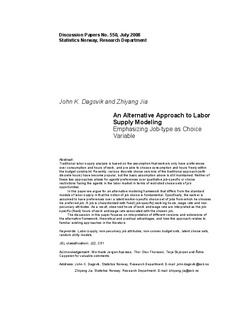| dc.contributor.author | Dagsvik, John K. | |
| dc.contributor.author | Jia, Zhiyang | |
| dc.date.accessioned | 2011-10-08T10:40:39Z | |
| dc.date.available | 2011-10-08T10:40:39Z | |
| dc.date.issued | 2008 | |
| dc.identifier.issn | 1892-753x | |
| dc.identifier.uri | http://hdl.handle.net/11250/180143 | |
| dc.description | Abstracts with downloadable Discussion Papers
in PDF are available on the Internet:
http://www.ssb.no | en_US |
| dc.description.abstract | Abstract:
Traditional labor supply analysis is based on the assumption that workers only have preferences
over consumption and hours of work, and are able to choose consumption and hours freely within
the budget constraint. Recently, various discrete choice versions of the traditional approach (with
discrete hours) have become popular, but the basic assumption above is still maintained. Neither of
these two approaches allows for agents’preferences over qualitative job-specific or choice
restrictions facing the agents in the labor market in terms of restricted choice sets of job
opportunities.
In this paper we argue for an alternative modeling framework that differs from the standard
models of labor supply in that the notion of job choice is fundamental. Specifically, the worker is
assumed to have preferences over a latent worker-specific choice set of jobs from which he chooses
his preferred job. A job is characterized with fixed (job-specific) working hours, wage rate and nonpecuniary
attributes. As a result, observed hours of work and wage rate are interpreted as the jobspecific
(fixed) hours of work and wage rate associated with the chosen job.
The discussion in this paper focuses on interpretation of different versions and extensions of
the alternative framework, theoretical and practical advantages, and how this approach relates to
familiar existing approaches in the literature. | en_US |
| dc.language.iso | eng | en_US |
| dc.publisher | Statistics Norway | en_US |
| dc.relation.ispartofseries | Discussion Papers;No. 550 | |
| dc.subject | Labor supply | en_US |
| dc.subject | Latent choice sets | en_US |
| dc.subject | non-pecuniary job attributes | en_US |
| dc.subject | Random utility models | en_US |
| dc.subject | non-convex budget sets | en_US |
| dc.subject | JEL classification: J22 | en_US |
| dc.subject | JEL classification: C51 | en_US |
| dc.title | An alternative approach to labor supply modeling : emphasizing job-type as choice variable | en_US |
| dc.type | Working paper | en_US |
| dc.subject.nsi | VDP::Social science: 200::Economics: 210 | en_US |
| dc.source.pagenumber | 43 s. | en_US |
